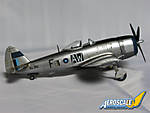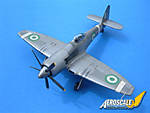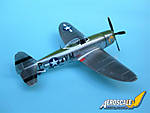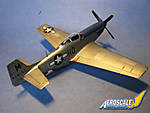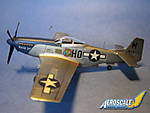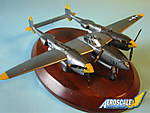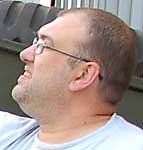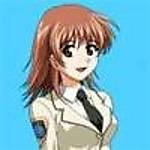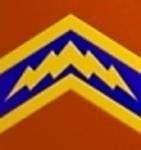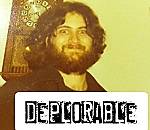Alclad Adventures
19
Comments
The Models
While the process followed is essentially the same. The five examples show different finishes achieved using variations on the technique.Tamiya P-47 Thunderbolt. Single Alclad2 base colour. No panel line wash.
PM Models Sea Fury. Single colour base coat. Some variation in Alclad shades. A dusty dirty finish.
Tamiya P-47 Thunderbolt MKII. Single colour base. Panels painted in different shades symmetrically. Oil wash.
Tamiya P-51 Mustang. Single colour base. Asymmetrical panel variation. Oil wash.
Dragon P-38J Lightning. Single colour base. Asymmetrical panel variation. Pro- Modeller wash.
Tamiya P-47 Thunderbolt. Kokomo.
The model was first sprayed with Tamiya Gloss Black, as a base coat for the Alclad2 Polished Aluminium. As it was the first time Id used Alclad I decided after the base coat of Polished Aluminium that I was going to get out while the going was good and not attempt to paint any panels in different shades. Panel line washes were definitely not my strongest point either at the time of the build so I didnít give the model one of these either. So what you see is just a single colour Alclad over Gloss Black. Klear was only applied to matt areas where the decals were going to be applied, such as the cowling.
Youíll see that the gloss black base coat gives an impression of the panel lines without an extra wash.
As this model depicts the personal Tíbolt of an 8th USAAF Group CO its shown in immaculate condition with no weathering.
PM Models Sea Fury.
My second Alclad adventure and the required finish was the opposite of my first effort. The Sea Fury was built for the Suez Campaign and depicts one of the Furyís operated by the Egyptian Air Force.
As before, the model received a base coat of Gloss Black and was then over-sprayed with Alclad Polished Aluminium. I then masked off a few on the larger panels and sprayed them with Alclad Dark Aluminium.
Alclad dries very quickly but I always leave it overnight before starting to mask off different panels and anti glare areas. My preferred masking tape is the Tamiya product and I havenít experienced any issues with it pulling Alclad away from the model. (famous last words! ) This serves to break up the otherwise uniform colour and gives some depth to the paint scheme.
At this point the model took a completely different path to my first.
As it was depicting a Sea Fury based at a desert air base in Egypt under combat conditions I elected to aim for a weathered and dusty appearance. After the wing stripes were painted on and decals applied I gave the model a couple of coats of Klear and then added a watercolour based light brown panel line wash. The whole model was then over-sprayed with a very thin (90% thinners 10% paint) mix of Tamiya Buff. The finishing touches were to sand back the leading edges of the wings to a polished sheen. This was done using the finest polishing stick I have, which was just abrasive enough to remove the Buff over-spray and leave the Alclad lacquer intact.
The Rumble In The East Asian Sky Campaign gave me the opportunity to build another of Tamiyas excellent 1:72 Bubbletops. This time in the guise of a Thunderbolt MKII in SEAC colours.
Gloss Black for primer as usual but this time I used Alclad Aluminium as the base lacquer. During the previous months I had picked up some other shades of Alclad and a series of masking sessions ensued as I masked and sprayed different panels in Polished Aluminium, Light Aluminium, Dark Aluminium, Duraluminium and Steel.
As much as possible this was done symmetrically, matching panels on the port and starboard wings with the same shade of Alclad.
Compare a photo of this model (photo 7) with the earlier Tamiya Bubbletop at the same stage. (photo 3), and youíll see how spraying the panels in different shades of Alclad really brings the NMF to life, adding depth and variation of tone.
On this aircraft I applied a couple of coats of Klear before adding a combination of decals and painted on markings. More Klear followed by an oil wash of Burnt Umber. The blue stripes were then reversed masked and sprayed with Matt Varnish. Finally I did the same thing with the olive drab anti glare panels.
I followed a very similar path with the Tamiya Mustang P-51D. However, instead of picking symmetrical panels to spray different shades of Alclad I just masked them randomly and followed no particular pattern when applying the Alclad. After an oil wash of burnt umber the model was finished with a coating of Humbrol Satin Varnish.
The final subject in this article is my recent build for the Twin Spinners Campaign. The Dragon P-38 Droop Snoot which I built as a standard P-38J.
The usual primer of Tamiya Gloss Black was over-sprayed with Alclad Aluminium. Various panels were picked out at random but because of the amount of colour in the paint scheme I didnít paint as many as on the previous two builds.
After a couple of coats of Klear I applied a wash from Pro Modeller instead of the usual oil wash. Pro modeller washes are a new product which I decided to try and they work very well.
http://www.promodeller.com/
No varnish was applied on the P-38, apart from the olive green anti glare sections.
So there you have it. 5 variations on a theme. Ranging from a single Alclad Polished Aluminium scheme with no panel line wash to multiple shades of Alclad over different panels with oil and pro-modeller washes. Satin Varnish, no varnish, and Klear finishes.
Apart from painting NMF planes you can also use Alclad for engines, undercarriage legs, in fact anything requiring a silver/metal finish. If your not using Chrome or Polished Aluminium youíll find that Alclad adheres well to acrylic primer or even Klear, but it does require a primer every time.
Finally when youíve finished spraying Alclad, youíll be wanting to clean your airbrush. This is done just as if you had been using acrylic paints. I use Isopropyl Alcohol for this.
I hope this answers some of the more common questions and has helped to encourage you to try a NMF sometime.
Comments
Thanks Nigel I will have to give that a try when I get round to the 1/24 Mustang. be prepared for more questions
JUL 20, 2008 - 07:14 PM
This may help...
Here's some scans of the instructions that I got wrapped round a bottle of Alclad once.
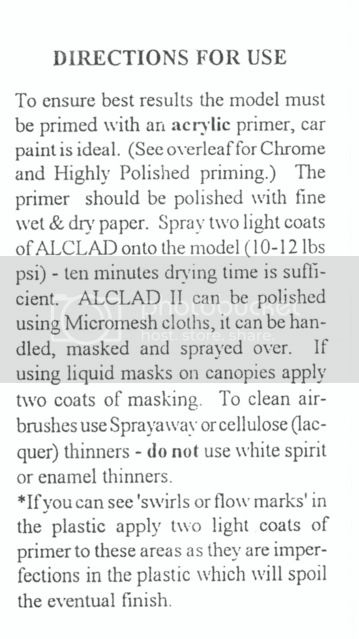
 Cheers
Allen
Cheers
Allen

 Cheers
Allen
Cheers
AllenAUG 09, 2008 - 08:15 AM
Oh boy did I just screw it up... used the alclad and everything went fine and dandy then used a bit of mm plate alum. and the world blew up it crazed. well I think it is salvageable but for now this superbolt is back in the box .... what a bummer this day became. live and learn i guess
Kelly
NOV 25, 2008 - 06:32 AM
Hmmm I never knew you used alcohol to clean your airbrush after using Alclad.. Might give it a go now.
Thanks Nige
SEP 25, 2011 - 10:46 AM
Hi Warren.
Yep, Isoproyl alcohol works a treat.
I also use it if I need to strip a panel and repaint.
Mask off the area along the nearest convenient panel lines using Tamiya tape, and very gently rub at the paint using a cotton bud/Q-tip just dampened with isopropyl.
At the edges, swipe from the masking tape onto the area being stripped and not the other way round. This way you don't force isopropyl under the masking tape.
On this P-47, most of both wings and a section of the starboard fusalage were stripped (as far onto the build as the decal stage) amongst many other individual panels, and repainted.
A bit scary the first time you attempt it but once you've done it a couple of times you get used to it.
 Hope this helps
Nige
Hope this helps
Nige
SEP 25, 2011 - 09:45 PM
Nigel, really enjoyed your article on NMFs. Just loaded with sound, basic methods, and advice.
Joel
JUL 24, 2013 - 02:36 AM
I can confirm the alclad black primer is bad news - didn't ever cure in my case either.
And for what it is worth, I have used the tamiya spray bottle gloss black as a primer layer (which is a lacquer base, not acrylic) under alclad metallics with good success - but you do have to keep the alclad coats very light and build up in coats, as nigel said, or the alclad might attack the lacquer (hasn't happened to me yet tho).
JUL 24, 2013 - 03:52 AM
I'm glad this thread has been bumped up again, I hope it encourages a few more folks to try the NMF schemes.
I always use Tamiya black semi-gloss acrylic as my Alclad primer and have never had any problems. I also mask and spray the anti glare panels and stripes over the Alclad after just an hour or so drying, usually using "post-it notes" as the masking, they are extremely low-tack and never lift the paint underneath.
Cheers, D
JUL 24, 2013 - 10:27 AM
Blimey, is it really over 5 years since I wrote this article??
It takes me almost that long to finish a model these days!
Really glad that all this time afterwards it's still encouraging people to give a nmf a go
Cheers,
Nige
JUL 24, 2013 - 01:45 PM
You have no idea how much encouragement that article did for me. I will now face painting my bubble top with far less fear than I had before.
Thanks Nigel, Joel and Jessica for all the advice you guys give so generously.
OCT 07, 2016 - 03:59 PM
Copyright ©2021 by Nigel Julian. Images also by copyright holder unless otherwise noted. The views and opinions expressed herein are solely the views and opinions of the authors and/or contributors to this Web site and do not necessarily represent the views and/or opinions of AeroScale, KitMaker Network, or Silver Star Enterrpises. Images also by copyright holder unless otherwise noted. Opinions expressed are those of the author(s) and not necessarily those of AeroScale. All rights reserved. Originally published on: 2008-05-31 00:00:00. Unique Reads: 19441




